Machine Learning in Freeway Ramp Metering BY JAKE TWAROG '24 Cover Image: A ramp meter on the Sylvan westbound entrance to I-26 in Portland, Oregon. There is another meter not pictured on the other side. "STOP HERE ON RED" is illuminated when the ramp meter is active. Image Source: Wikimedia Commons
Introduction Despite their purpose as a means for mass transportation, freeways are known for the antithesis to that goal: traffic. They are susceptible to interruption and delay, which has a cascading effect and can keep traffic sticking around long after its initial source has been resolved. Traffic is difficult to predict, even with new, modernized equipment for measuring network flow, such as dedicated probe vehicles and smartphones (Zhang, 2015). In addition, after traffic becomes dense, it is hard to return flow to stable levels. Traffic generated by highway entrances, called "on-ramps," can be especially problematic at peak hours. On-ramps, particularly when their access is controlled by a traffic light, send large groups of cars known as "platoons" onto the highway. These platoons interfere with the ongoing flow of the freeway, causing significant jams. One technique that has been used to combat this is called ramp metering. Ramp metering was introduced in the United States in 1963 on I-290 in Chicago and has spread outward since then to other major urban areas (Yang, 2019). Despite being similar in appearance to traffic lights, ramp meters functionally act quite differently; they often lack
19
yellow lights, and when there is more than one lane, each lane gets their own light. Although often frustrating for drivers due to the addition of an additional light to a freeway commute, ramp metering is proven to help reduce on-ramp traffic by breaking up platoons. In the presence of either a reduction in flow or a bottleneck, reducing the number of vehicles that can access the freeway at once significantly helps reduce their impacts (Haboian, 1995). This paper will discuss the algorithmic implementation of ramp metering and how this can improve its implementation and use.
Fixed Parameter Algorithms To maximize the efficiency of on-ramp flow, the use of ramp meters must be tightly optimized to avoid delays when traffic on the freeway is light. Many different types of algorithms have been used to determine both when a ramp meter's active periods should be and what their light timings should be. Two currently existing strategies for ramp metering are known as the RWS strategy and the ALINEA strategy. The RWS strategy is a simple strategy that integrates the number of vehicles that can enter the freeway as a function of k, i.e. r(k). Metering systems DARTMOUTH UNDERGRADUATE JOURNAL OF SCIENCE











